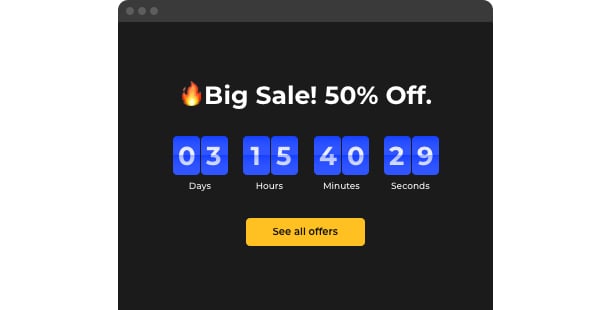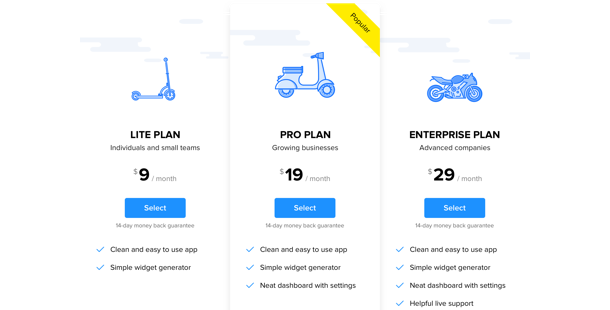Best Website Builder for Selling
How to create a Selling website from the scratch or upgrade the one you’ve already built on the basis of any CMS or website builder
Things to consider when you create a selling website
Every site serves as a resolution of some particular issue and has a core audience obligingly. To start with, you need to pin down all the tasks you are to cover. Generally, selling websites are aiming to have the following elements:
Get more customer calls and boost sales

Stimulate users’ anxiety to make a buy

Cut down shopping cart abandonment

Help users make decision

Highlight your most attractive deals

Uplevel your trustworthiness

Pick the most relevant website platform
All websites are shaped on the basis of some platform – for example, a website builder. They suit approximately everyone as they make it much easier to construct your own site without programming work. More often it’s less costly to employ a site builder than to hire an experienced developer. You can begin with finding the most preferable builder from an array below, then choose a template for your future selling website – and you’re halfway through!
Squarespace
Wix
WordPress
Overall ratings
Create your dream website with the most relevant website builders. Using the comparative chart below, you may do a check of the influential characteristics of the platforms and select the one that absolutely meets your needs for the prospective website.
| Squarespace | WordPress | Wix | |
| Free Plan | trial | free | free *limited functionality |
| Paid From (mo.) | $12.00 | free | $13 |
| Overall | 4.4 out of 5 | 4.3 out of 5 | 4.2 out of 5 |
| Quality of Support | 8.5 | 7.7 | 7.9 |
| Ease of Setup | 8.8 | 8.1 | 7.9 |
| Templates | 10+ | 1000+ * most are paid | 75+ |
| Our widgets for Platforms | Widget List | Plugin Catalog | App library |
Just after you pick a Site Builder for making Selling website, always pay regard for website performance and good value for money. Use a trial period or free version to try out the service. This is one of the best ways to realize if the website Builder is truly as convenient and practical as they picture it.
Selling website examples
Check a list of the most popular Selling templates. They all have specific structure, parts and design. Decide upon the most relevant Selling style concept for your inspiration.

Example 1: Slime Store website
This powerful template drives you to perceive more about products and services offered. It also has exceptional style that offers a adaptable arrangement.

Example 2: Shoe Store website
This splendid template drives you to find out more about merchandis and services granted. It also has awesome design that offers a flexible arrangement.

Example 3: Pet Supply Store website
This is a multipurpose template that’s a great idea to make a selling website! Accompanied by a couple of free widgets, it will undeniably help you stand out from your competitors.
Fill in your selling website
When you’ve selected your site platform and a relevant template, it’s time to generate your site pages to fill them with information and widgets to supply all the needs described STEP 1. Generally, a site has the following pages:
Homepage →
Here you present your business and welcome your customers by providing them with all the necessary info about the current discounts, sales and more. Also, this page should contain all the links to the second level pages.
Category overview →
It’s a landing page for all the categories on your website like, for example, Woman dresses, denim, etc. In case your business has only one category of goods, this page will be replaced with a Category page which presents products under specific categories.
Product card →
This page contains all the info about one specific product, for example, sizes and colors available, left in stock, etc. Also has an “add to cart” button.
Cart →
Here users can overview the goods they’ve chosen and select what they want to purchase. You can also place some promo codes here and demonstrate shipping costs.
Contact →
This area of your website should contain your emails, phone numbers, messengers, links to social media accounts and postal address in case you’ve got one.
Test and launch
Before your website for selling products is launched, you have to make sure everything works as intended. This useful checklist will aid you in not to omit a single important step.
-
Test your mobile efficiency.
These days it’s exceedingly important that your site performes and looks good on mobile devices for more than half of your users will open it with their smartphones.
-
Add your logo.
If you haven’t got it, create it using a logo generator, for example, Tailor Brands.
-
Connect your domain.
In case you haven’t got it while using the website builder, you need to buy it now. Use GoDaddy to start with.
-
Poke around the functionality
All sliders, pop-ups, CTAs or social media buttons must work in due course, otherwise, your visitors will close your site in a bit of a hurry.
-
Announce your site launch on social media.
Make the online audience into real clients. Adjoin a link to your website to your social media accounts to the end that your subscribers could see it.
-
Done! 🏆
Congratulations! Now you’re a site owner. Now share the link to your website with friends and all clients and start collecting the feedback – it will aid you to attract more clients. And don’t stop upgrading your content and functionality to achieve even greater success.


